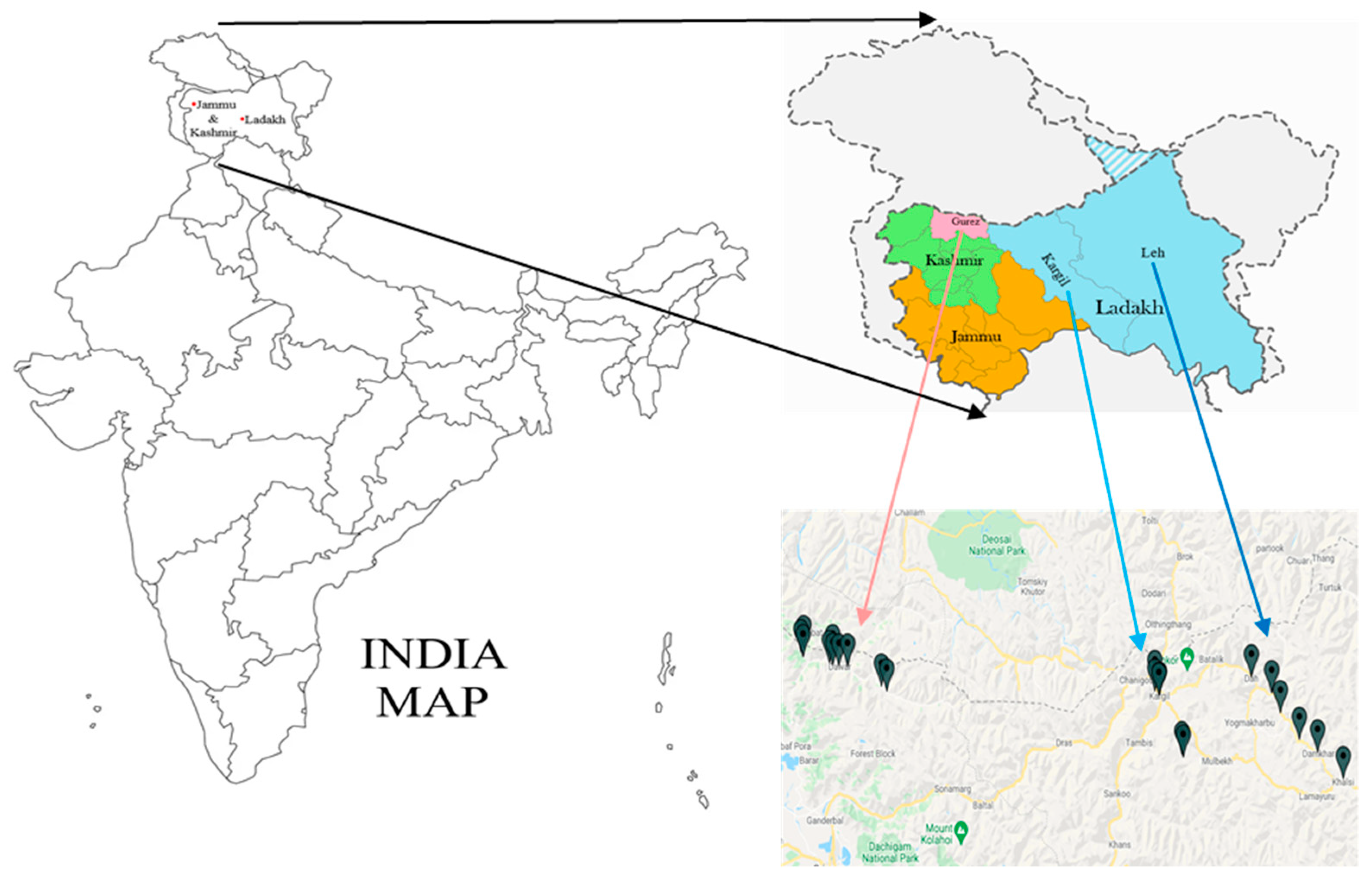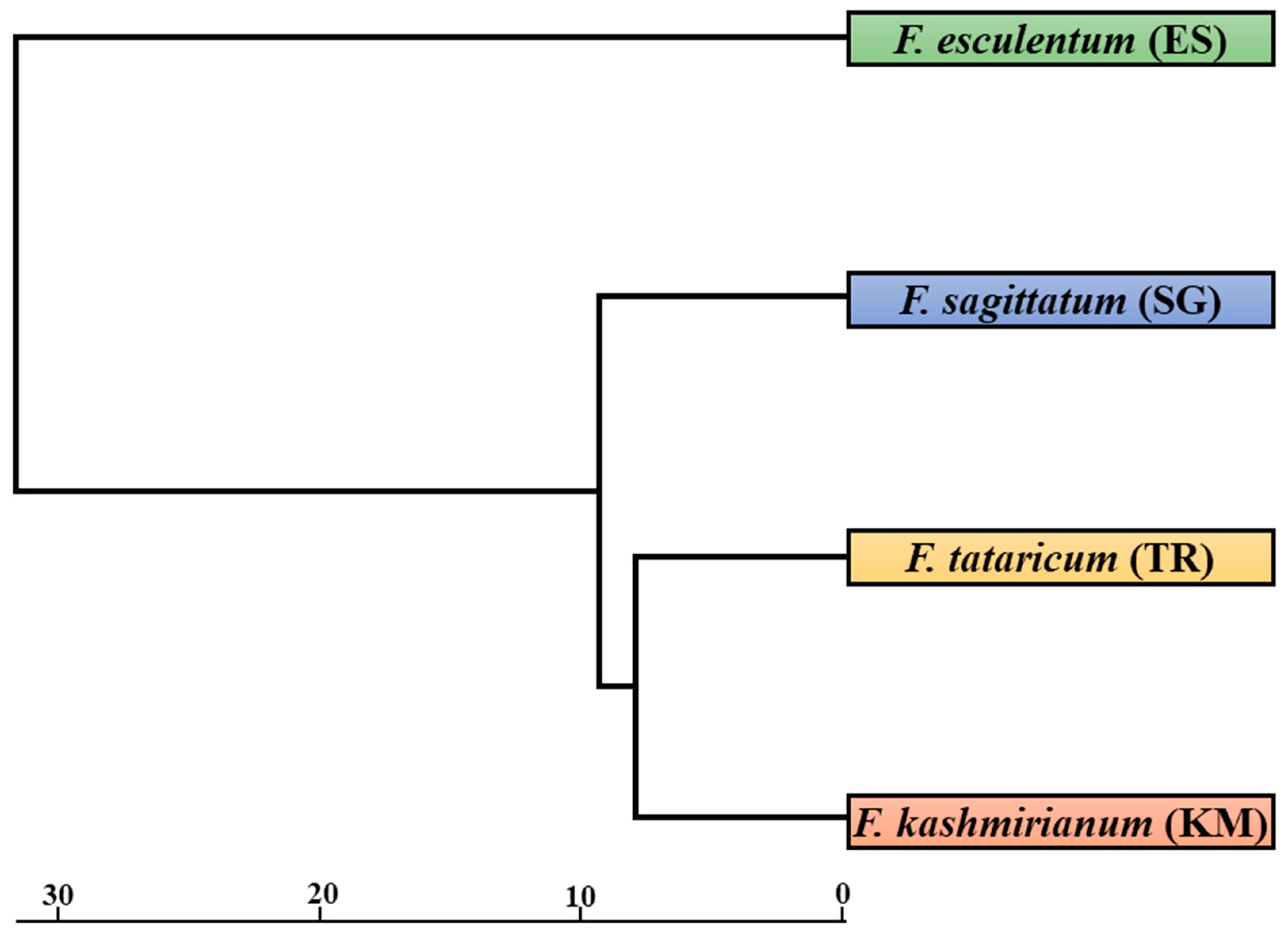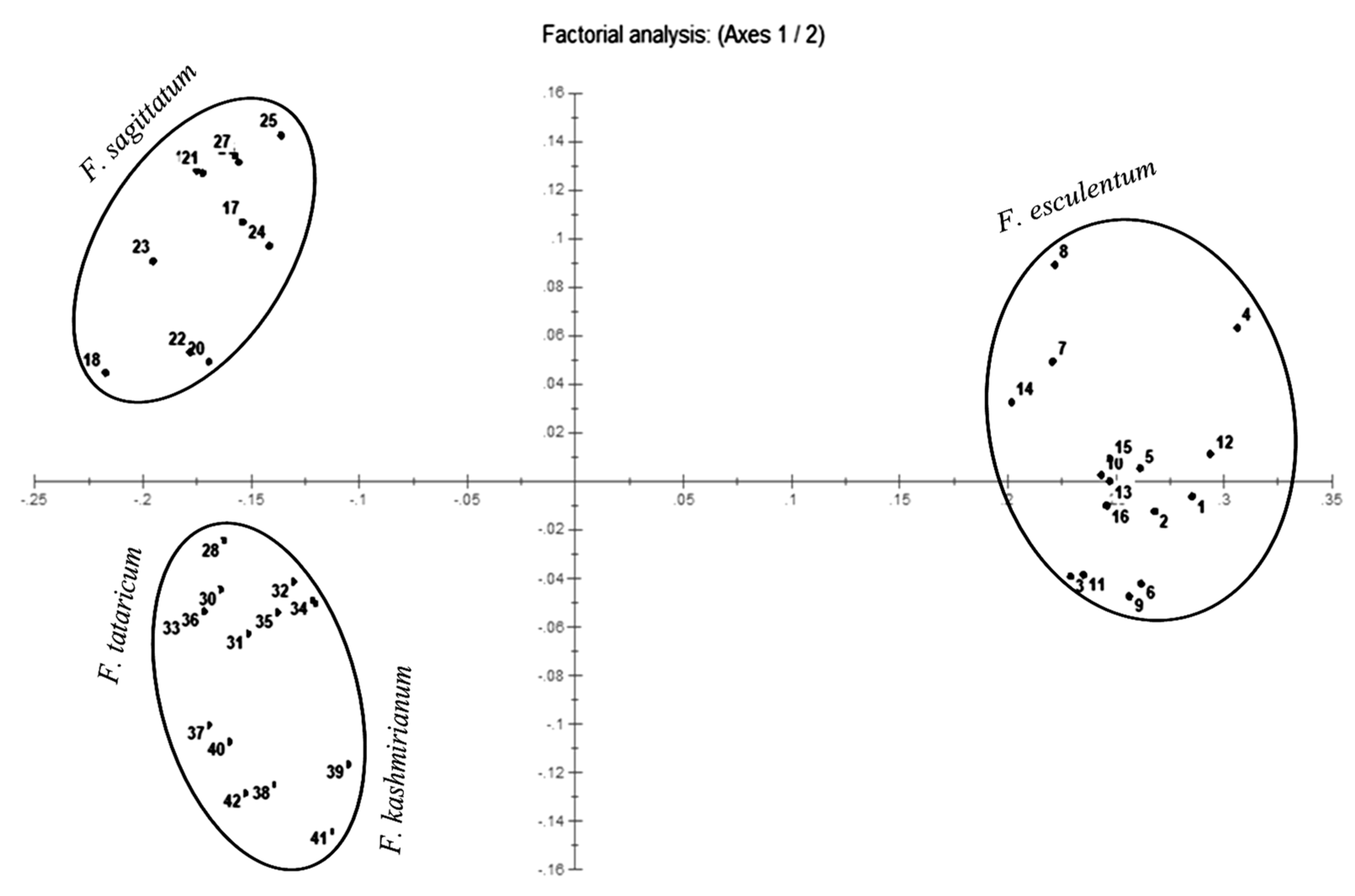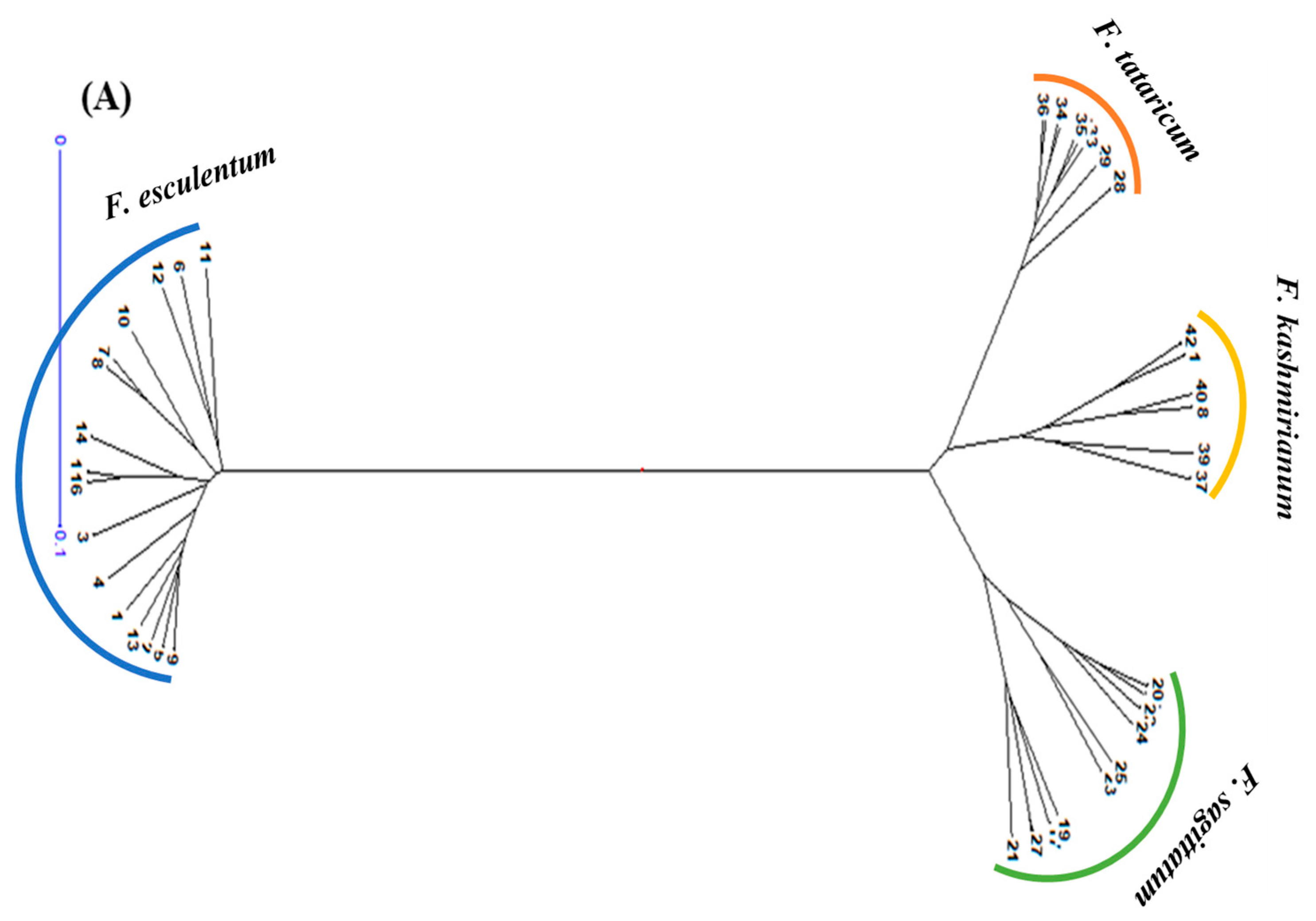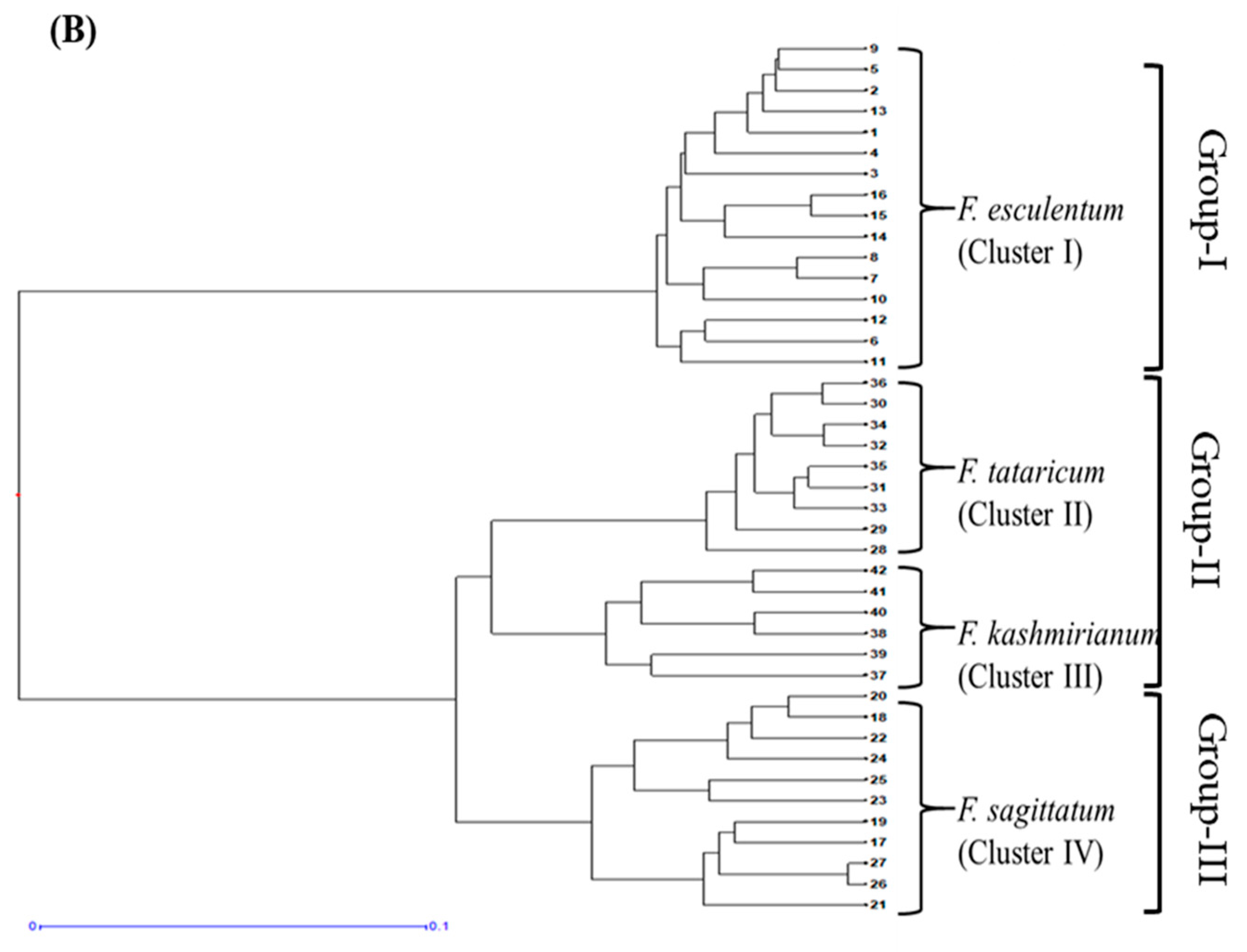In the present study, 42 accessions of four buckwheat species (
F. esculentum,
F. sagittatum,
F. tataricum and
F. kashmirianum) were collected from Kashmir (Gurez district) and Ladakh (Kargil and Leh districts) in order to acquire a deeper insight into their population structure and genetic variability at the species level. The present investigation utilizing ISSR markers revealed the availability of considerable polymorphism for the development of buckwheat cultivars by assessing the extent and distribution of genetic variability, as well as percentage polymorphic bands (PPB). The genetic structure of buckwheat species also provides an idea about the various interactive processes including its long-term evolutionary history (changes in distribution pattern, habitat isolation, species variation and population structure) in addition to mating strategy, mutation, genetic drift, selection and gene flow. Moreover, the ecological and geographical distributions also influence the genetic diversity of different plant species [
55].
4.1. Genetic Variability at Intra-Specific and Inter-Specific Level in Fagopyrum Species
The genome of
Fagopyrum species indicated a high amount of allelic genetic variation, variety and differentiation. The extent of variation observed has been based on geographical distribution, fertilization, habitat isolation, gene flow and selection pressure that results in the evolution of genotypes in divergent agro-ecological zones. The data obtained using 12 ISSR primers presented different levels of percentage polymorphic bands (PPB) as
F. esculentum (32.35%),
F. sagittatum (28.43%),
F. tataricum (17.65%) and
F. kashmirianum (26.47%) within the accessions of buckwheat species (
Table 3). This suggests that accessions of
F. esculentum,
F. sagittatum and
F. kashmirianum exhibited significant levels of genetic variation in comparison to accessions of
F. tataricum during the present study. This significant level of percentage polymorphism and genetic variation within the accessions (
F. esculentum,
F. sagittatum and
F. kashmirianum) may be attributed to its diverse geographical distribution, pollinating behaviour, biological traits and selection pressure. Conversely, a comparatively low level of percentage polymorphism and genetic variability within the accessions of
F. tataricum may be due to its declined cultivation among farmers, least consumption rate, self-pollination and absence of germplasm exchange among farmers. In addition, low levels of genetic diversity in plant species depend upon various factors from breeding systems, seed dispersal mechanism, altitudinal/geographical ranges and natural selection. It has been considered that altitudinal/geographical ranges play a crucial role in the maintenance of genetic variation among most of the factors mentioned above [
56,
57]. Thus, a close relationship has been found within the populations/accessions collected from similar locations having the same environmental conditions followed by seed exchange among these regions. These geographical variables result in the populations/accessions having a restricted genetic base. Furthermore, a certain geographic region may possess stable ecological characteristics, and low temperature may be a decisive factor in this case. Other variables that might contribute to limited intra-specific genetic diversity include altitude fluctuation and human involvement. Moreover, it has also been reported that cross-pollinating plant species tend to exhibit more diversity within populations than species that are mostly self-pollinating and genetically less diverse [
58,
59]. In the case of accessions of
F. tataricum, which is a self-pollinating plant species, and, thus, exhibits a comparatively low level of genetic variation in addition to the factors discussed above, although the accessions were collected from diverse ecological sites. In this study, the ISSR markers that worked on accessions of buckwheat species proved to be quite efficient in detecting the significant level of polymorphism percentage (
Table 2). Given the advantages of ISSR markers, the present study was based on genetic diversity and relationships within and among the accessions of buckwheat species (
Figure 3). Furthermore, the use of pre-screened and randomly selected highly informative primers contributed to the study’s effectiveness in detecting significant polymorphism.
Furthermore, Nei’s genetic diversity (
H) and Shannon’s information indices (
I) values suggested that a significant amount of genetic variation present within the accessions of buckwheat species. Nei’s genetic diversity (
H) and Shannon’s information indices (
I) were significantly high within the accessions of
F. esculentum (
H = 0.1164;
I = 0.1715),
F. sagittatum (
H = 0.1144;
I = 0.1691) and
F. kashmirianum (
H = 1149;
I = 0.1649). However, both the values were comparatively low within the accessions of
F. tataricum (
H = 0.0707;
I = 0.1028), as depicted in
Table 3. Likewise, the genetic diversity of 10 wild and 2 cultivated buckwheat species including four newly discovered wild species from South-Western Sichuan buckwheats has been analysed using karyotypes, allozymes and ISSR markers, which revealed a high degree of genetic variation especially among South-Western Sichuan buckwheats due to the complex domestication process in this crop [
60]. Similar results were obtained from the genetic variability study in Tartary buckwheat using SSR and ISSR markers [
61,
62]. Furthermore, using a set of eight nuclear SSR markers, molecular characterization of 11 accessions of common buckwheat (
Fagopyrum esculentum Moench), 9 from Italy and 2 from Poland and Nepal revealed that the majority of genetic diversity was found within populations of common buckwheat [
38].
The values of Nei’s genetic diversity (
H) at the intra-specific and inter-specific levels are the indicators of total genetic polymorphism present in the species. The Nei’s genetic diversity (
H) revealed that total species diversity (
HT = 0.3200) has been significantly higher than intra-specific genetic diversity (
HS = 0.1040), signifying the distinctiveness of each species analysed in this study. It is, therefore, not unexpected to find the low extent of diversity existing at the intra-specific level (32.53%) than at the inter-specific level (67.47%) during the present study (
Table 4). When the findings of this study have been compared to the results of AMOVA, it has been observed that 27% of variation existed within the accessions of buckwheat species (intra-specific diversity), whereas 73% of variation existed among the accessions of buckwheat species (inter-specific diversity) and thereby confirmed the above findings (
Table 5). The coefficient of genetic differentiation value (
GST = 0.6747) also indicates that a significant degree of genetic variation has been distributed across the accessions of
Fagopyrum species. Similar findings have been reported on 27 cultivars (5 of
F. tataricum and 22 of
F. esculentum) of buckwheat species collected from diverse geographical areas of the world which indicated significant intra-specific polymorphism using ISSR markers. It has also been reported from the same study that domestic cultivars of
F. esculentum exhibited greater inter-varietal polymorphism than wild forms [
63]. Senthilkumaran et al. [
64] made a similar finding while evaluating the genetic diversity of
F. esculentum,
F. tataricum and
F. cymosum accessions by using phenotypic and RAPD markers. These regions also follow conventional agricultural practices and utilizing the stored germplasm in succeeding generations without any germplasm exchange, which may contribute to maintaining its genetic diversity through stabilization of specific local adaptations [
62,
65,
66].
A rather high amount of genetic variation was identified among the accessions of the
Fagopyrum species in this study (
Table 4 and
Table 5). Analysis of ISSR data using various statistical software programs such as Popgene, GenAlEx and DARwin ascertained comparable findings about the genetic structure of the buckwheat species. One of the major reasons for a higher level of genetic diversity amongst the buckwheat accessions is the inter-specific genetics and also the contributions made from altitudinal/geographical ranges. In order to retain their wide geographic spread, plants of a specific species must adapt to a variety of environmental conditions. Consequently, many common species have evolved into a succession of ecological races or exhibit significant phenotypic flexibility as a result of their great genetic variety [
67,
68]. As a result, the level of genetic variability present in a plant species, as well as its distribution, is a critical element in determining its long-term viability, fitness and evolutionary potential [
69].
The presence of genetic variations as reflected by the varying number of alleles at each locus and their frequency of distribution determines the amount of polymorphism in a given species or population. Heterozygosity refers to the chance of utilizing DNA-based molecular markers to identify two alleles randomly selected from a population. Thus, Nei’s genetic diversity (
H), Shannon’s information index (
I), coefficient of genetic differentiation (
GST) and estimate of gene flow (
Nm) in plant populations may be used to provide a quantitative assessment of marker utility and polymorphism identified. Moreover, it has been proposed that plants adjust variously to selection pressures in diverse environments [
62].
4.2. Relationship at Intra-Specific and Inter-Specific Level in Fagopyrum Species
The present study revealed that the
FST (fixation index) distance between accessions of buckwheat species ranged from 0.618 (between accessions of
F. kashmirianum (KM) and
F. tataricum (TR)) to 0.898 (between accessions of
F. tataricum (TR) and
F. esculentum (ES)), as shown in
Table 6. Similarly, Nei’s unbiased measures of genetic distance between accessions of buckwheat species ranged from 0.1607 (between accessions of
F. kashmirianum (KM) and
F. tataricum(TR)) to 0.6701 (between accessions of
F. tataricum (TR) and
F. esculentum (ES)) (
Table 7). Thus, the values from both the analyses indicated that accessions of
F. esculentum have the greatest distance from the other accessions of
F. sagittatum,
F. kashmirianum and
F. tataricum. UPGMA dendrogram also indicated that accessions of
F. esculentum are genetically most distant as compared to other accessions of buckwheat species (
Figure 4). Its unusual genetic architecture can be attributed to several factors including cross-pollinating nature and can even be confirmed by its unique morphological features than the other species of buckwheat.
PCoA combined with cluster analysis is a powerful method for extracting valuable details from molecular data. Principal coordinate analysis (PCoA) revealed the distribution pattern of accessions of buckwheat species along the 2D-coordinate axes. Accessions of
F. esculentum have been distributed on one side of the coordinate axes and also exhibit more dispersion in comparison to the accessions of other species. Conversely, accessions of
F. sagittatum,
F. tataricum and
F. kashmirianum have been distributed on the other side of the coordinate axes (
Figure 5). Moreover, the accessions of
F. tataricum and
F. kashmirianum have been closely dispersed and shared the same space along with the coordinate system. This indicates that the genetic similarity shared by the accessions of
Fagopyrum tataricum and
Fagopyrum kashmirianum, respectively. Conversely, the UPGMA dendrogram based on Jaccard’s dissimilarity coefficient grouped the 42 accessions of buckwheat species into four major clusters and three groups. Cluster-I comprised the accessions of
F. esculentum, cluster-II comprised
F. tataricum, cluster-III comprised
F. kashmirianum and cluster-IV comprised
F. sagittatum (
Figure 6). Here, the accessions of
F. tataricum and
F. kashmirianum have also been grouped as they are evolving from the same root of UPGMA dendrogram indicating that they might have descended from the common ancestor. Moreover, different accessions collected from various sites of each species were assembled into the same major cluster. In general, the results obtained from PCoA and cluster analysis complemented one another during the present study. Similar observations were made during morphological characterization of 18
F. esculentum Moench and 18
F. sagittatum Gilib accessions gathered from diverse agro-ecological locations of north-western regions of India [
70].
The need for the improvement of buckwheat genetics by various breeding programmes has been realized globally. Buckwheat is a promising pseudocereal crop; therefore, substantial information about the intra-specific and inter-specific genetic variation of its germplasm collections is of fundamental importance for crop improvement. Nevertheless, little is known about intra-specific and inter-specific genetic variations and the relations within and among the buckwheat accessions, and the results presented in this study might augment a new understanding.
